Dealing with a biting dog can be challenging and potentially dangerous, but it is essential to address this behavior for the safety of both the dog and its owner. Putting a collar on a biting dog requires patience, understanding, and a systematic approach.
So, In this blog post, we will provide a step-by-step guide on how to put a collar on a dog that bites and ensure the process is stress-free and can promote a positive relationship between the dog and its handler.
What Is Dog Collar Sensitivity?
Dog collar sensitivity refers to a behavioral issue in dogs where they exhibit signs of discomfort, fear, or aggression when their collar is touched or when someone attempts to put the collar on them. This sensitivity can manifest as growling, snapping, or biting as a defensive response to what the dog perceives as a threat or source of stress.

Many dogs are introduced to collars at a young age when they are puppies. Proper collar training during this critical period can help them get accustomed to the sensation of wearing a collar, and they learn to accept it as a normal part of their daily routine.
However, not all dogs receive this early training, and some may have negative experiences associated with collars, leading to sensitivity issues later on.
Why Does My Dog Won’t Let Me Put Collar On? (10 Reasons)
There could be several reasons why your dog aggressive when putting on collar. Dogs may display this behavior due to various underlying factors, and it’s essential to understand these potential reasons to address the issue appropriately.
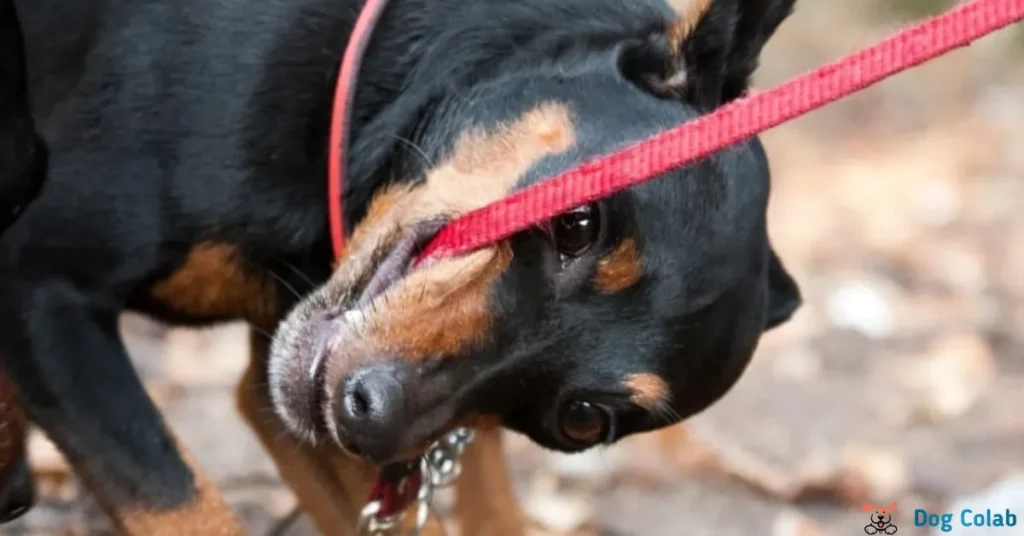
Here are some common reasons.
1. Fear or Anxiety
Your dog may associate the act of putting on the collar with negative experiences, such as going to unfamiliar places, being scolded, or receiving medical treatments. Consequently, they may become anxious or fearful when you attempt to put on the collar, leading to defensive behavior like biting.
2. Past Trauma
If your dog has experienced a traumatic event related to collars in the past, such as getting tangled or caught, it might exhibit fear or aggression when a collar is introduced again.
3. Lack of Socialization
Insufficient exposure to different experiences and handling during the early stages of a dog’s life can lead to fear or discomfort with certain objects, including collars.
4. Pain or Discomfort
If your dog is experiencing any underlying pain or medical issues, they may perceive the collar as a source of discomfort, causing them to react aggressively to avoid the discomfort.

5. Resource Guarding
Dogs are known to guard their possessions, and if your dog views the collar as their possession, it may become defensive and bite to protect it.
6. Lack of Training
If your dog hasn’t been properly trained to accept the collar and associate it with positive experiences, it might react defensively when you try to put it on.
7. Dominance or Territorial Behavior
In some cases, dogs may bite as a way to establish dominance or control over a situation they perceive as a challenge.
8. Redirected Aggression
If your dog is already feeling stressed or agitated due to external stimuli, it may redirect its aggression onto you when you attempt to put on the collar.
10. Behavioral Issues
Dogs with certain behavioral problems may resort to aggression as a coping mechanism when faced with situations they find stressful or uncomfortable.
How To Put A Collar On A Dog That Bites? (A Step-By-Step Guide)
If you have a dog that bites, it’s important to approach the process of putting a collar on them with caution and patience. Handling a dog with a biting issue requires sensitivity and safety measures to prevent any harm to you or the dog.
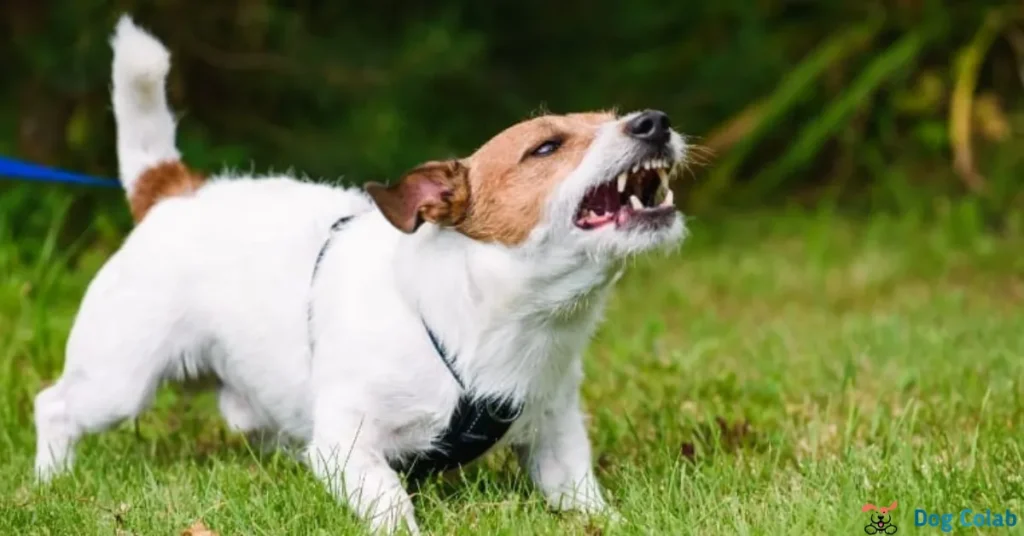
Below are some steps for how to put a collar on an aggressive dog that bites.
1. Preparation
- Choose the Right Collar: Opt for a flat buckle collar or a martingale collar rather than a slip or choke collar. These collars are less likely to cause harm or discomfort to the dog.
- Use a Lightweight Leash: Select a soft and lightweight leash that doesn’t add any additional stress to the dog.
2. Desensitization
- Gradual Exposure: Before attempting to put the collar on, familiarize the dog with the collar and leash by placing them nearby and letting the dog sniff them. This helps desensitize the dog to these new objects.
- Positive Associations: Use treats and positive reinforcement to create a positive association with the collar and leash. Reward the dog for showing interest in or being near the collar.
3. Practice Handling
- Gentle Touches: Start by gently touching the dog’s neck area with your hand to get them used to being handled in that area.
- Incremental Steps: Gradually work towards touching and holding the collar near the dog’s neck without actually fastening it. Reward the dog for calm behavior during each step.
4. Safety Measures
- Muzzle: If your dog has a history of biting and you are concerned about your safety, consider using a basket muzzle during the process of putting on the collar. A basket muzzle allows the dog to breathe and drink freely while preventing them from biting.
5. The Collaring Process
- Have Assistance: If possible, have another person present to help you. They can distract or engage the dog while you focus on putting on the collar.
- Remain Calm and Patient: Dogs can sense your emotions, so it’s essential to stay calm and patient throughout the process. Avoid showing fear or frustration.
- Use Treats: Have treats ready to reward the dog for calm behavior and compliance.
- Slow and Steady: Gradually bring the collar closer to the dog’s neck and gently fasten it. Keep the process slow and avoid sudden movements that might startle the dog.
- Reward and Praise: Once the collar is on, give the dog praise and treats as positive reinforcement.
You may also be interested in:- How to stop dog barking.
How to Handle A Dog’s Collar Properly?

- Approach Calmly: Approach the dog calmly and avoid sudden movements that might startle them. This is especially important if the dog is not familiar with you.
- Stay Relaxed: Dogs are sensitive to human emotions, so try to remain relaxed while interacting with them. If you’re nervous or tense, the dog might pick up on that and react accordingly.
- Position Yourself Safely: Stand or crouch to the side of the dog rather than directly in front of them. This approach is less intimidating and reduces the risk of the dog feeling threatened.
- Gently Touch the Collar: With the owner’s permission, gently touch or hold the collar to familiarize the dog with your touch. Some dogs may be sensitive around their neck area, so be gentle and patient.
- Use Positive Reinforcement: If the dog is anxious or fearful of having their collar handled, use positive reinforcement to associate collar touching with good things. Offer treats or praise when the dog remains calm and allows you to handle its collar.
- Check for Proper Fit: Ensure that the collar fits the dog correctly. It should be snug enough not to slip off, but not too tight collar that it causes discomfort or restricts breathing. Between the collar and the dog’s neck, you should be able to fit two fingers comfortably.
How To Put a Collar On a Dog That Never Has Worn One?
Here’s a step-by-step guide on how to put a collar on a dog thats scared or that never has worn one.
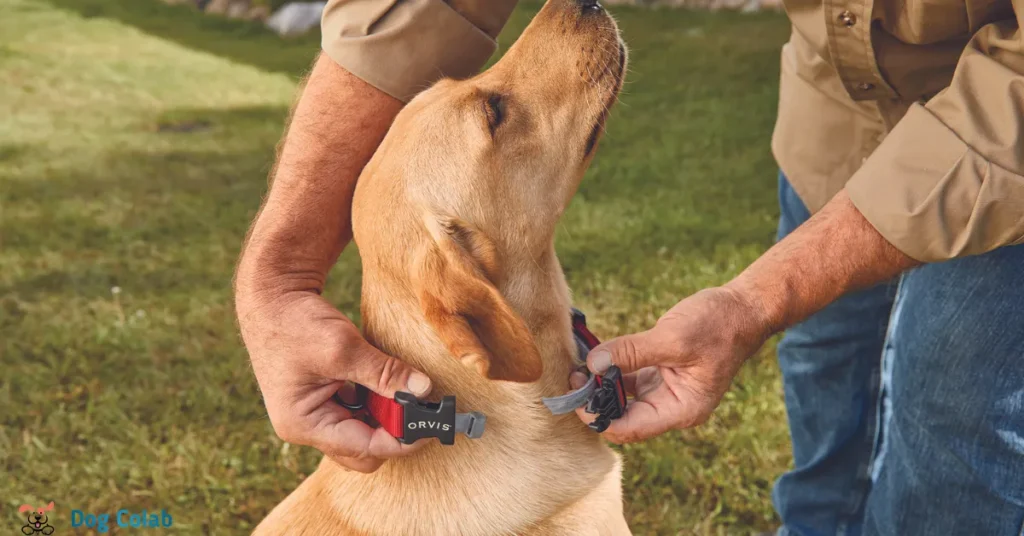
- Choose the Right Collar: Select a comfortable and appropriately sized collar for your dog. There are various types of collars available, including buckle collars, quick-release collars, martingale collars, and harnesses. Consider your dog’s size, breed, and specific needs when making your choice.
- Familiarize Your Dog With the Collar: Before putting the collar on, let your dog sniff and investigate it. Allow them to get used to the new object and associate it with positive experiences.
- Positive Association: Create positive associations with the collar by offering treats, verbal praise, or petting when your dog shows interest in or approaches the collar. This helps to build positive reinforcement and decreases any anxiety they may have about the collar.
- Gradual Introduction: For the first few days, let your dog wear the collar loosely for short periods indoors. This helps them get used to the feeling of having something around their neck.
- Gradually Tighten the Collar: Once your dog is comfortable with the loose collar, gradually tighten it to the appropriate fit. Make sure you can easily slide two fingers under the collar to ensure it’s not too tight.
- Distractions and Play: While your dog wears the collar, engage them in fun activities or play with their favorite toys. This can help take their mind off the new sensation and promote a positive experience.
- Supervision: While your dog is wearing the collar during the initial stages, keep a close eye on them. If you notice any signs of discomfort or irritation, remove the collar and try again later.
- Remove the Collar at Times: Give your dog breaks from wearing the collar, especially during bedtime or when they are resting. This allows them to have periods without any restrictions.
- Encourage Good Behavior: Reinforce positive behavior while your dog is wearing the collar. Reward them with treats, praise, or playtime when they behave calmly and accept the collar.
Why Is My Dog Suddenly Aggressive Towards Me?
When a previously friendly and affectionate dog suddenly becomes aggressive towards its owner, it can be concerning and puzzling. There are various reasons why this behavioral change might occur. Medical issues should be the first consideration, as pain or discomfort can make a dog aggressive.
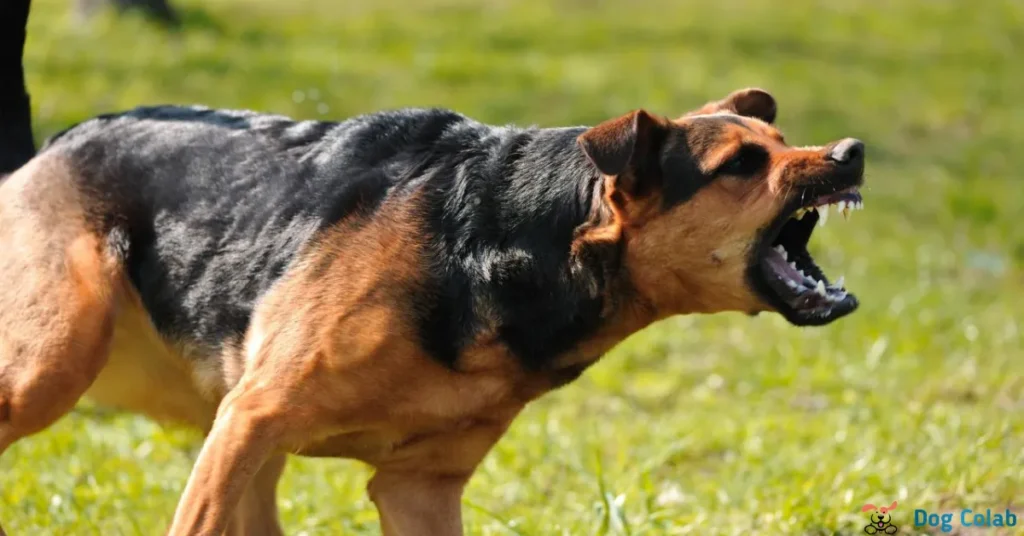
Consulting a veterinarian to rule out any underlying health problems is crucial. Changes in the dog’s environment, routine, or social interactions can also trigger aggression. Dogs are creatures of habit, and disruptions to their familiar surroundings can cause stress and anxiety, leading to defensive behavior.
Additionally, traumatic experiences, such as past abuse or a recent frightening event, can leave a lasting impact on a dog’s psyche, causing them to respond aggressively out of fear or self-preservation. Sometimes, aggressive behavior might be rooted in dominance issues, where the dog feels the need to assert control over their owner.
Understanding the specific triggers and seeking the help of a professional dog trainer or animal behaviorist can be instrumental in identifying the root cause and implementing a tailored plan to address and manage the aggression appropriately.
Recommended Also Read:- Why dog freaks out when takes his collar off.
What To Do When My Puppy Hates His Collar?
It’s not uncommon for puppies or dogs to dislike wearing collars, as they may find them uncomfortable or restrictive. However, if do dogs hate collars, it’s essential for their safety and training to get them used to wearing one.
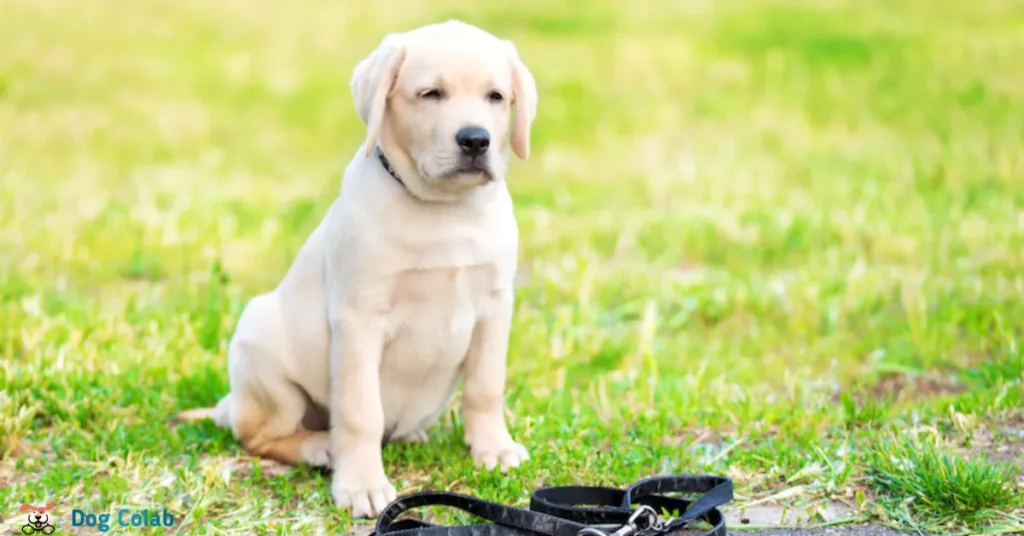
Here are some steps you can take to help your dog become more comfortable with their collar.
1. Gradual Introduction
Avoid forcing the collar on your puppy immediately. Instead, introduce the collar gradually. Start by letting your puppy sniff and explore the collar without wearing it. Offer treats and positive reinforcement when your puppy shows interest or interacts with the collar. This helps create a positive association.
2. Positive Reinforcement
Use positive reinforcement techniques to associate the collar with pleasant experiences. Each time your puppy willingly approaches or allows you to put on the collar, reward them with treats, or playtime. Make sure the experience of wearing the collar is linked to positive emotions.
3. Short and Positive Sessions
Begin with short sessions of collar-wearing and gradually increase the duration as your puppy becomes more comfortable. Keep these sessions positive and engaging, so your puppy doesn’t feel overwhelmed or stressed.
4. Comfortable Collar Selection
Ensure the collar you choose fits properly and is comfortable for your puppy. Avoid collars that are too tight or too loose, as they can cause discomfort and lead to negative associations. Look for soft and lightweight materials that won’t irritate your puppy’s skin.
5. Distraction and Play
Engage your puppy in play or activities while they are wearing the collar. This helps divert their attention away from the discomfort and normalizes the feeling of having the collar on. Play games, practice commands, or go for a short walk with your puppy to keep them occupied.
How Long Does It Take For a Puppy To Get Used To a Collar?
The time it takes for a dog to get used to wearing a collar can vary significantly depending on the individual dog and its temperament. Some dogs may adapt quickly within a few hours, while others may take several days or even weeks.

It’s essential to introduce the collar gradually and positively. Start by letting the dog sniff and explore the collar before putting it on, rewarding them with treats and praise for their curiosity. Initially, keep the collar on for short periods, gradually increasing the duration to allow the dog to acclimate to the sensation.
Reading Tip:- Why dog tries to bite when puts his collar on.
How To Stop Puppy Biting When Putting Collar On?
Teaching a puppy to stop biting when putting on a collar is an essential part of their training. Puppies explore the world with their mouths, and this behavior is quite common, but it needs to be redirected.

Here are some steps to help you stop puppy biting when putting on a collar.
- Start With Positive Associations: Associate the collar with positive experiences. Allow the puppy to sniff and play with the collar before trying to put it on. Offer treats and praise while showing them the collar, so they associate it with good things.
- Get the Right Fit: Ensure you have the correct size collar for your puppy. If it is too tight, it will cause discomfort. However, it should be snug enough to prevent it from slipping off.
- Practice Touch Sensitivity: Gradually desensitize your puppy to touch around its neck. Gently stroke and touch their neck area, rewarding them with treats and praise for remaining calm.
- Use Distractions: Have some toys or treats ready to distract your puppy while you put on the collar. Offer the toy or treat while you gently slip the collar over their head or buckle it around their neck.
- Positive Reinforcement: Use positive reinforcement techniques. Reward your puppy with treats when they stay calm and don’t bite during the collar application process.
- Stay Calm: It’s important to remain calm and patient throughout the process. If you get frustrated or stressed, your puppy may pick up on this and become anxious or agitated.
- Redirect Behavior: If your puppy starts to bite while putting on the collar, redirect their attention to a toy or treat. Avoid yelling or punishment, as this can create negative associations with the collar.
- Training Sessions: Set aside short training sessions each day to work specifically on collar-wearing behavior. Regular, focused training will yield better results.
Conclusion “How To Put A Collar On a Dog That Bites”
Collaring a biting dog requires a patient and understanding approach. By using desensitization techniques, positive reinforcement training, and gentle handling, you can create a positive association between the dog and the collar. Always prioritize safety and seek professional guidance when dealing with severe cases of biting behavior. With time and consistent training, you can foster a strong bond with your dog based on trust and mutual respect.
NOTE:- More information can be found by clicking this link.
FAQs
1. What to do with a dog that bites their owner?
Yelp when the dog bites, walk away, and ignore for 30-60 seconds. If persists, leave the room for 30-60 seconds. Consistent response teaches dog biting is unacceptable. Seek professional help if needed.
2. How do you break aggression in a dog?
To break aggression in a dog, implement a behavior modification program that includes trigger avoidance, teaching new responses, positive reinforcement, head halter and leash control, and desensitization to significant triggers.
3. How do you calm a stray aggressive dog?
To calm an aggressive stray dog, avoid dominance or anger. Use calming signals: yawn, avoid eye contact, stand sideways, and crouch down, allowing the dog to sniff you if comfortable.

